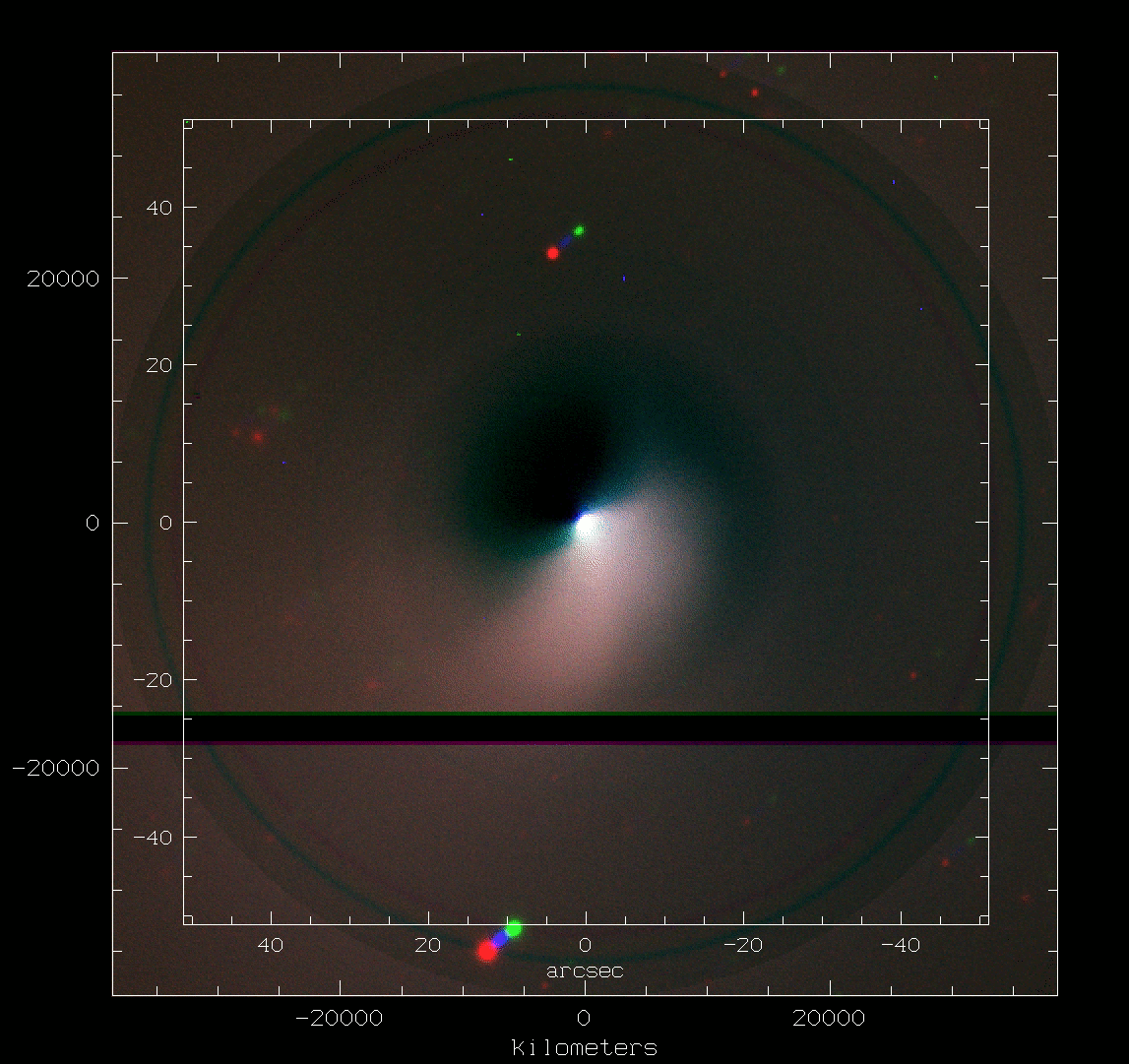VLT First Images of Comet Tempel 1 After Impact
July 5, 08:00 CEST - Garching.
On the night of July 4, 2005, all ESO telescopes continued their extensive observing campaign of Comet Tempel 1. But this time, they were able to see the effect of the impact on the comet. The astronomers were clearly not disappointed.
![]()
TIMMI2 images of Comet Tempel 1, before (left) and after (right) impact.
The impact occurred at 07:52 CEST but because the comet has already set in Chile at that time, observers at the La Silla Paranal Observatory could only start observing several hours later. The first observations were done in the infrared by TMMI2 at the 3.6m telescope at La Silla, at 21:20 CEST (still daylight in Chile).
These first observations showed the comet to be 2 to 3 times brighter in the infrared than the day before the impact. The coma is also much more extended than it was until before the impact.
At sunset in Chile, all 7 telescopes of the La Silla Paranal Observatory went into operations. The FORS2 multi-mode instrument on Antu, one of the 8.2m Unit Telescope of the VLT array, took stunning images, showing that the morphology of the comet had dramatically changed: a new bright fan-like structure was now visible.
![]()
FORS2 images of Comet Tempel 1, before (top) and after (bottom) impact.
The fan lies in the southern part of the image and is rather bright and well defined. This feature is an addition to those that were already visible during the previous days, that seems to still be underlying the new one. Behind this fan, the old coma from yesterday is still present. The new structure is about 15,000 km large, indicating that the matter has been ejected with a speed of about 700 to 1,000 km/h.

The FORS2 image azimuthally enhanced. The fact that the big plume is not uniform in colour is indicative of different speeds for particles of different sizes.
Further observations during the week will study the evolution of this fan, revealing if the probe has activated a new region of the surface and how long that region remains active.
The fan is visible through the reflection of sunlight on dust grains. The fact that the big plume is not uniform in colour probably indicates that different dust size are traveling at different speeds.
![]()
NACO Image of the Central Part of the Coma
Other telescopes have provided observations of the comet as well. NACO took some images of the central part of the coma, while UVES performed high-dispersion spectroscopy of the comet, in order to compare with the previous nights. First estimates indicate the emission lines to be more pronounced by 10 to 20 %.
![]()
SOFI image in the J-band of Comet Tempel 1 after the impact.
At La Silla, the SOFI instrument at the NTT telescope, imaged the comet in the near-infared. An image in the J-band also shows the dust shell from the impact in the south-western quadrant of the coma. The very inner coma (indicated by the white box) shows on-going enhanced activity compared to the pre-impact level.
The astronomers at the La Silla Paranal Observatory will continue to observe Comet Tempel 1 for another four days in order to monitor precisely its long-term behaviour.
Note
[1]: Leading scientists of the ESO DI campaign: H. Boehnhardt (MPI, Lindau, Germany), O. Hainaut (ESO), H.U. Kaufl (ESO), H. Rauer (DLR, Germany).
Members of the ESO DI observing team on site: N. Ageorges (ESO, Chile), S. Bagnulo (ESO, Chile), L. Barrera (UMCE, Chile), H. Boehnhardt (MPS, Germany), T. Bonev (Astr. Inst. Sofia, Bulgaria), O. Hainaut (ESO, Chile), E. Jehin (ESO, Chile), H.U. Kaufl (ESO, Germany), F. Kerber (ESO, Germany), J. Manfroid (U.Liège, Belgium), O. Marco (ESO, Chile), E. Pantin (CEA, France), E. Pompei (ESO, Chile), C. Sterken (Vrije Universiteit Brussel, Belgium), G.P. Tozzi (Obs. Arcetri, Italy), M. Weiler (DLR, Germany)
Members of the ESO DI observing team not on site: C. Arpigny (U.Liège, Belgium), A. Cochran (McDonald, USA), C. Delahodde (Univ. Florida, USA), Y. Fernandez (Univ. Hawaii, USA), D. Hutsemekers (U.Liège, Belgium), H. Kawakita (Gunma, Japan), J. Knollenberg (DLR, Germany), L. Kolokolova (Univ. Maryland, USA), M. Kretlow (MPS, Germany), M. Kueppers (MPS, Germany), E. Kuehrt (DLR, Germany), L. Lara (IAA, Spain), J. Licandro (IAC, Spain), C. Lisse (Univ. Maryland, USA), K. Meech (U.Hawaii, USA), R. Schulz (ESTEC, The Netherlands), G. Schwehm (ESTEC, The Netherlands), M. Sterzik (ESO, Chile), J.A. Stüwe (Leiden, The Netherlands), I. Surdej (Univ. Liège, Belgium and ESO, Garching), D. Wooden (Ames, USA), J.-M. Zucconi (Besancon, France)